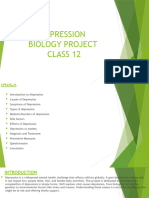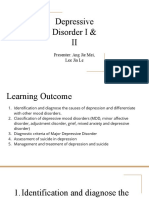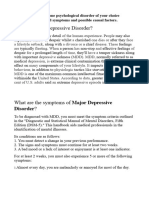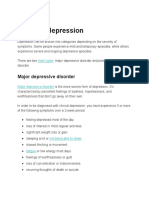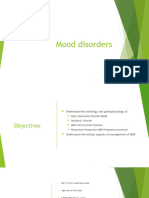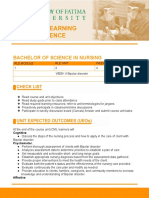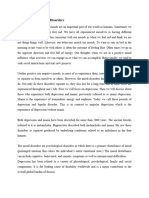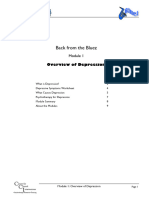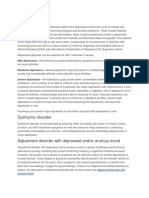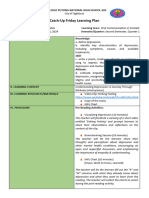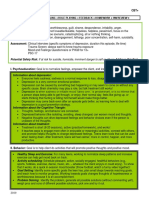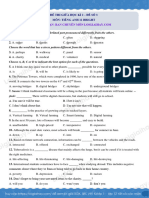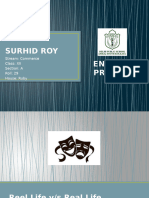0 ratings0% found this document useful (0 votes)
14 viewsDepression Assignment
Depression Assignment
Uploaded by
Nidhi MalviyaMajor depressive disorder (MDD) is characterized by persistent feelings of sadness, hopelessness, and lack of interest that interfere with daily life. A case study describes a 33-year-old woman experiencing symptoms of MDD including difficulty concentrating, insomnia, appetite loss, and feelings of worthlessness. Her symptoms began after work and family stressors and have worsened over months. Her treatment plan includes cognitive behavioral therapy, antidepressant medication if needed, lifestyle changes, and family support to regulate her mood and alleviate depression.
Copyright:
© All Rights Reserved
Available Formats
Download as DOCX, PDF, TXT or read online from Scribd
Depression Assignment
Depression Assignment
Uploaded by
Nidhi Malviya0 ratings0% found this document useful (0 votes)
14 views8 pagesMajor depressive disorder (MDD) is characterized by persistent feelings of sadness, hopelessness, and lack of interest that interfere with daily life. A case study describes a 33-year-old woman experiencing symptoms of MDD including difficulty concentrating, insomnia, appetite loss, and feelings of worthlessness. Her symptoms began after work and family stressors and have worsened over months. Her treatment plan includes cognitive behavioral therapy, antidepressant medication if needed, lifestyle changes, and family support to regulate her mood and alleviate depression.
Original Description:
Psychology assignment
Copyright
© © All Rights Reserved
Available Formats
DOCX, PDF, TXT or read online from Scribd
Share this document
Did you find this document useful?
Is this content inappropriate?
Major depressive disorder (MDD) is characterized by persistent feelings of sadness, hopelessness, and lack of interest that interfere with daily life. A case study describes a 33-year-old woman experiencing symptoms of MDD including difficulty concentrating, insomnia, appetite loss, and feelings of worthlessness. Her symptoms began after work and family stressors and have worsened over months. Her treatment plan includes cognitive behavioral therapy, antidepressant medication if needed, lifestyle changes, and family support to regulate her mood and alleviate depression.
Copyright:
© All Rights Reserved
Available Formats
Download as DOCX, PDF, TXT or read online from Scribd
Download as docx, pdf, or txt
0 ratings0% found this document useful (0 votes)
14 views8 pagesDepression Assignment
Depression Assignment
Uploaded by
Nidhi MalviyaMajor depressive disorder (MDD) is characterized by persistent feelings of sadness, hopelessness, and lack of interest that interfere with daily life. A case study describes a 33-year-old woman experiencing symptoms of MDD including difficulty concentrating, insomnia, appetite loss, and feelings of worthlessness. Her symptoms began after work and family stressors and have worsened over months. Her treatment plan includes cognitive behavioral therapy, antidepressant medication if needed, lifestyle changes, and family support to regulate her mood and alleviate depression.
Copyright:
© All Rights Reserved
Available Formats
Download as DOCX, PDF, TXT or read online from Scribd
Download as docx, pdf, or txt
You are on page 1of 8
Depression Theory Assignment -Submitted by Nidhi Malviya
Q1. Examine the major types of Depression
Answer : Depression is a complex mental health condition with various types,
each characterized by specific symptoms and triggers. Here's an examination of
some major types of depression:
1. Major Depressive Disorder (MDD):
Description: MDD, often referred to as clinical depression, is
characterized by persistent and intense feelings of sadness,
hopelessness, and a lack of interest or pleasure in activities.
Symptoms interfere significantly with daily life and functioning.
Symptoms: Include a depressed mood, loss of interest or pleasure,
changes in appetite and sleep patterns, fatigue, feelings of
worthlessness or guilt, difficulty concentrating, and recurrent
thoughts of death or suicide.
Duration: Symptoms persist for at least two weeks.
2. Persistent Depressive Disorder (Dysthymia):
Description: Dysthymia is a chronic form of depression lasting for
at least two years. While the symptoms might be less severe than
MDD, they are persistent and can significantly impair daily
functioning.
Symptoms: Similar to MDD but less severe, and they persist over a
long period. People with dysthymia often describe themselves as
consistently unhappy or as having a "low" mood.
3. Bipolar Disorder:
Description: Bipolar disorder involves periods of major depression
alternating with periods of mania or hypomania (less severe
mania). Manic episodes are characterized by elevated mood,
increased energy, and impulsive behavior.
Symptoms: During depressive episodes, symptoms resemble
those of MDD. During manic episodes, individuals might
experience elevated mood, increased activity, reduced need for
sleep, grandiosity, and impulsive behavior.
4. Seasonal Affective Disorder (SAD):
Description: SAD is a type of depression that occurs seasonally,
typically in the fall and winter months when there is less sunlight.
It is thought to be related to changes in light exposure.
Symptoms: Symptoms are similar to MDD but occur in a seasonal
pattern. People with SAD may experience low energy,
hypersomnia, overeating, and social withdrawal during specific
seasons.
5. Postpartum Depression (PPD):
Description: PPD occurs after childbirth and is often triggered by
hormonal changes, stress, and lack of sleep. It affects both
mothers and fathers.
Symptoms: Similar to MDD but occur after giving birth. Symptoms
can include mood swings, crying spells, anxiety, and difficulty
bonding with the baby.
6. Premenstrual Dysphoric Disorder (PMDD):
Description: PMDD is a severe form of premenstrual syndrome
(PMS) characterized by significant depressive symptoms,
irritability, and tension before menstruation.
Symptoms: Symptoms are similar to MDD but occur in a cyclical
pattern before menstruation and improve after menstruation
begins.
7. Disruptive Mood Dysregulation Disorder (DMDD): DMDD is a childhood-
onset disorder characterized by severe temper outbursts that are out of
proportion to the situation and a consistently irritable or angry mood. It
is diagnosed in children and adolescents.
8. Cyclothymic Disorder: Cyclothymic disorder is a milder form of bipolar
disorder. It involves chronic mood disturbances with numerous episodes
of hypomanic and depressive symptoms that do not meet the criteria for
a full-blown manic or depressive episode.
Each type of depression has unique features and may require specific
approaches to treatment. It's essential for individuals experiencing symptoms
of depression to seek professional help for accurate diagnosis and appropriate
treatment.
Q2. Elaborate the signs and symptoms of Postpartum Depression
Postpartum depression (PPD) is a form of clinical depression that affects some
individuals after childbirth. It's important to recognize that PPD can affect both
mothers and fathers. Here are the signs and symptoms of postpartum
depression:
1. Persistent Sadness or Low Mood: Feeling persistently sad, hopeless, or
experiencing an overwhelming sense of sadness that doesn't go away.
2. Loss of Interest or Pleasure: Losing interest in activities that were once
enjoyable, including activities related to the baby or other hobbies.
3. Changes in Appetite and Sleep Patterns: Significant changes in appetite
or weight, either an increase (resulting in weight gain) or a decrease
(resulting in weight loss). Sleep disturbances, such as insomnia or
excessive sleep, are common.
4. Fatigue and Lack of Energy: Feeling extremely tired, even after sleeping,
and lacking the energy to perform daily tasks.
5. Feelings of Worthlessness or Guilt: Having strong feelings of
worthlessness or excessive guilt, often about not being a good parent or
feeling like a burden to others.
6. Difficulty Bonding with the Baby: Having trouble forming an emotional
attachment or bonding with the baby. Feeling disconnected from the
baby, or not feeling the expected maternal or paternal instincts.
7. Irritability or Agitation: Feeling unusually irritable, angry, or agitated,
even over small matters.
8. Difficulty Concentrating: Finding it hard to focus, make decisions, or
remember things, often referred to as "mommy brain" but more severe
in the case of PPD.
9. Intrusive Thoughts: Having disturbing thoughts, sometimes of harming
oneself or the baby, although these thoughts are typically not acted
upon and cause significant distress.
10.Physical Symptoms: Some individuals with PPD may experience physical
symptoms such as headaches or stomachaches that don't have any other
medical cause.
11.Social Withdrawal: Withdrawing from friends and family, avoiding social
gatherings, and feeling a strong desire to be alone.
12.Fear of Harming the Baby: An intense fear of being left alone with the
baby, even though there is no rational reason for this fear.
It's essential to note that experiencing one or two of these symptoms
temporarily is common for new parents due to stress and lack of sleep.
However, if these symptoms persist for more than two weeks and significantly
interfere with daily functioning, it's crucial to seek help from a healthcare
professional.
Postpartum depression can be treated effectively with therapy, support groups,
medication, or a combination of these approaches. Early intervention is vital
for the well-being of both the parent and the baby.
Q3. Construct a case study of Major Depressive Disorder
Answer : Case Study: Major Depressive Disorder
Patient Profile: Name: Nikita Age: 33 years Occupation: Marketing Professional
Background: Nikita is a successful marketing manager living in Bangalore, India.
She is married and has two children. Nikita has always been career-oriented
and managed a demanding job while taking care of her family.
Presenting Problem: Nikita has been experiencing persistent feelings of
sadness, hopelessness, and a lack of interest or pleasure in activities she used
to enjoy for the past six months. She finds it difficult to concentrate at work,
struggles to complete tasks, and has withdrawn from her friends and family.
Nikita is also having difficulty sleeping, experiencing insomnia most nights. She
has lost her appetite and has unintentionally lost weight over the past few
months. Nikita feels overwhelming fatigue even after a full night's sleep. She
often has negative thoughts about herself, feeling worthless and guilty about
minor things.
Clinical Assessment: Nikita exhibits classic symptoms of Major Depressive
Disorder (MDD). Her symptoms significantly impair her daily functioning, both
at work and at home. She meets the criteria for MDD as per the Diagnostic and
Statistical Manual of Mental Disorders (DSM-5).
History: Nikita reports that her symptoms began gradually, following a
particularly stressful period at work where she had to manage a high-pressure
marketing campaign. During this time, she was also dealing with her mother's
illness, which added emotional strain. Nikita’s symptoms have worsened over
the past few months, impacting her ability to cope with her responsibilities and
enjoy her life.
Treatment Plan: Nikita’s case requires a comprehensive treatment plan
involving therapy and, possibly, medication:
1. Psychotherapy (Cognitive Behavioral Therapy - CBT): Nikita will engage
in CBT sessions with a licensed therapist. CBT aims to identify and
change negative thought patterns and behaviors. Through therapy, Nikita
can learn coping strategies and develop a more positive outlook.
2. Medication: Considering the severity of Nikita’s symptoms, her
psychiatrist may prescribe antidepressant medication, such as selective
serotonin reuptake inhibitors (SSRIs), to help regulate her mood and
alleviate the symptoms of depression.
3. Lifestyle Changes: Nikita will be encouraged to incorporate regular
exercise, proper nutrition, and sufficient sleep into her routine. These
lifestyle changes can positively impact her mood and energy levels.
4. Support System: Involving Nikita’s family in her therapy and ensuring she
has a strong support system at home will be crucial. Family support can
significantly contribute to her recovery.
5. Follow-up and Monitoring: Regular follow-up appointments with her
therapist and psychiatrist will be scheduled to monitor her progress,
adjust the treatment plan if necessary, and provide ongoing support.
Outcome: With consistent therapy, medication, and a supportive environment,
Nikita’s symptoms gradually improve over the course of several months.
Through therapy, she learns effective coping strategies, manages stress more
efficiently, and rebuilds her self-esteem. With time, Nikita is able to resume her
responsibilities at work and engage more fully with her family and friends,
marking a successful recovery from Major Depressive Disorder. Continued
therapy and support help her maintain her mental well-being and prevent
future episodes of depression.
Q4. Enumerate the techniques for treatment of Depression
Answer : Certainly, there are several effective techniques used in the treatment
of depression, often tailored to an individual's specific needs and the severity
of their condition. Here are some common techniques for treating depression:
1. Psychotherapy (Talk Therapy):
Cognitive-Behavioral Therapy (CBT): CBT helps individuals identify
and change negative thought patterns and behaviors. It focuses on
developing coping strategies and problem-solving skills.
Interpersonal Therapy (IPT): IPT focuses on improving
interpersonal relationships and communication skills to alleviate
depressive symptoms.
Psychodynamic Therapy: This therapy explores unconscious
thoughts and feelings, helping individuals understand how past
experiences influence current behaviors and emotions.
2. Medication:
Antidepressants: Various classes of antidepressant medications,
such as SSRIs (Selective Serotonin Reuptake Inhibitors) or SNRIs
(Serotonin and Norepinephrine Reuptake Inhibitors), can help
regulate neurotransmitters in the brain, improving mood and
reducing depressive symptoms.
Mood Stabilizers: In cases of bipolar depression, mood stabilizers
like lithium are used to manage mood swings.
Atypical Antipsychotics: Sometimes used in combination with
antidepressants, especially in severe or treatment-resistant
depression.
3. Brain Stimulation Therapies:
Electroconvulsive Therapy (ECT): ECT involves passing electrical
currents through the brain to induce controlled seizures. It is often
used for severe, treatment-resistant depression.
Transcranial Magnetic Stimulation (TMS): TMS uses magnetic
fields to stimulate nerve cells in the brain, particularly in the
prefrontal cortex, to alleviate depression symptoms.
4. Lifestyle Changes:
Regular Exercise: Physical activity can boost mood by increasing
the production of endorphins and promoting better sleep.
Healthy Diet: A balanced diet rich in omega-3 fatty acids, vitamins,
and minerals supports brain health and can positively impact
mood.
Adequate Sleep: Establishing a consistent sleep schedule and
ensuring sufficient rest is vital for managing depressive symptoms.
Mindfulness and Meditation: Practices like mindfulness-based
stress reduction (MBSR) and meditation can help individuals
manage negative thoughts and stress.
5. Supportive Interventions:
Support Groups: Participating in support groups allows individuals
to connect with others who are experiencing similar challenges,
reducing feelings of isolation.
Family Therapy: Involving family members in therapy sessions can
improve communication, understanding, and support within the
family unit.
Expressive Therapies: Art, music, or dance therapy can provide
creative outlets for expressing emotions and processing difficult
experiences.
6. Self-Help Strategies:
Journaling: Writing down thoughts and emotions can provide a
healthy outlet for self-reflection and emotional expression.
Relaxation Techniques: Practices like deep breathing, progressive
muscle relaxation, or yoga can help reduce stress and promote
relaxation.
Setting Realistic Goals: Establishing achievable short-term goals
can provide a sense of purpose and accomplishment.
It's important to note that the effectiveness of these techniques can vary from
person to person. Often, a combination of therapies tailored to an individual's
specific needs yields the best results. Additionally, seeking professional
guidance from mental health practitioners is crucial to determine the most
suitable treatment approach for each individual.
You might also like
- Mood Disorder - DR - AHMED KAMELDocument64 pagesMood Disorder - DR - AHMED KAMELPIH SHTNo ratings yet
- Abnormal Psychology Module 7 Mood DisordersDocument30 pagesAbnormal Psychology Module 7 Mood DisordersSumriddhi SrivastavaNo ratings yet
- Multipath Model of Depressive DisordersDocument2 pagesMultipath Model of Depressive DisordersNadazhda Nikita50% (2)
- DepressionDocument23 pagesDepressionsainichhavi0852No ratings yet
- Unveiling Depression: Identifying, Implementing, and Embracing SolutionsFrom EverandUnveiling Depression: Identifying, Implementing, and Embracing SolutionsNo ratings yet
- Week 20 Reading 1Document10 pagesWeek 20 Reading 1Karim KamalNo ratings yet
- Mood Disorders - Exploring DepressionDocument46 pagesMood Disorders - Exploring DepressionCounsel IndiaNo ratings yet
- Mood Disorders - DepressionDocument21 pagesMood Disorders - Depressionpatriciagemayel4No ratings yet
- Mood Disorders2Document73 pagesMood Disorders2Crisia GungobNo ratings yet
- Mood Disorders - Version 3Document12 pagesMood Disorders - Version 3ahmed.omer222555No ratings yet
- Mood DisordersDocument5 pagesMood DisordersSandraNo ratings yet
- Chapter 3 Mood and Anxiety DisordersDocument14 pagesChapter 3 Mood and Anxiety DisordersDessirie EnriquezNo ratings yet
- Clinical Notes 1Document17 pagesClinical Notes 1sathmi gurusingheNo ratings yet
- DEPRESSIONDocument21 pagesDEPRESSIONASMITA SHARMANo ratings yet
- Abnormal 3 and 4Document39 pagesAbnormal 3 and 4momireemaot7No ratings yet
- Abnormal Psychology PDF 3Document81 pagesAbnormal Psychology PDF 3Mawi BadNo ratings yet
- Mood DisordersDocument54 pagesMood DisordersTanin LimsiriwongNo ratings yet
- TBL 3 - Depressive Disorder 1 - 2Document94 pagesTBL 3 - Depressive Disorder 1 - 2Tanyap LimleeNo ratings yet
- What Is Major Depressive Disorder?Document5 pagesWhat Is Major Depressive Disorder?kvj111111No ratings yet
- Types of DepressionDocument12 pagesTypes of DepressionKADAMBARI100% (1)
- Clinical Psychology Unit 1Document9 pagesClinical Psychology Unit 1NAMAN SINGHNo ratings yet
- Dysthymia BiruDocument39 pagesDysthymia Biruhilmi sallehNo ratings yet
- Understanding DepressionDocument2 pagesUnderstanding Depressionnic jNo ratings yet
- Depression Toolkit 1Document24 pagesDepression Toolkit 1aqsa shahidNo ratings yet
- Mental Health: Types and Management of Common Mental Disorders What Is Mental Illness or Disorder?Document3 pagesMental Health: Types and Management of Common Mental Disorders What Is Mental Illness or Disorder?Anne F. GoNo ratings yet
- Pertemuan 3 - Mood DisorderDocument39 pagesPertemuan 3 - Mood DisorderSara Kurnia KristiNo ratings yet
- Session 2 - Mood Disorders Tuesday, Jan. 11, 2022Document22 pagesSession 2 - Mood Disorders Tuesday, Jan. 11, 2022mohora1030No ratings yet
- Depression Bynoem DawoodDocument40 pagesDepression Bynoem DawoodHira KhanNo ratings yet
- UPD Mte 2Document11 pagesUPD Mte 2garimamahaur47No ratings yet
- 2 Mood DisorderDocument86 pages2 Mood DisorderAffaf MohammedNo ratings yet
- Depram & Antidepressant Medical KnowledgeDocument85 pagesDepram & Antidepressant Medical KnowledgePeter KaiserNo ratings yet
- Inp Week 4 Psychiatric Nursing (Bipolar Disorder)Document33 pagesInp Week 4 Psychiatric Nursing (Bipolar Disorder)Michelle Gliselle Guinto MallareNo ratings yet
- 1b Midterm Mood DisordersDocument29 pages1b Midterm Mood Disordersedwardjohn.floresNo ratings yet
- Symptoms of DepressionDocument2 pagesSymptoms of Depressionnmcculloughw0dyNo ratings yet
- U4L2 Student GuideDocument5 pagesU4L2 Student Guide-Esha-No ratings yet
- Case Summary #1: DepressionDocument7 pagesCase Summary #1: DepressionSam Raven AndresNo ratings yet
- Case Summary #1: DepressionDocument7 pagesCase Summary #1: DepressionSam Raven AndresNo ratings yet
- Depression ZubiDocument8 pagesDepression ZubiShafiq Ur RahmanNo ratings yet
- Cassia Edwards - Unit 3 - Part 5 - Depressive DisordersDocument6 pagesCassia Edwards - Unit 3 - Part 5 - Depressive Disorders185266No ratings yet
- Moderate Depression - Symptoms, Treatment, and CopingDocument14 pagesModerate Depression - Symptoms, Treatment, and CopingnajibNo ratings yet
- Altered Mood States DepressionDocument22 pagesAltered Mood States Depressionmushahida khatoonNo ratings yet
- DEPRESSIONDocument23 pagesDEPRESSIONsainichhavi0852No ratings yet
- DSM5 Disorders DefinitionsDocument8 pagesDSM5 Disorders Definitionsminhot525No ratings yet
- DocumentDocument4 pagesDocumentqzneskaNo ratings yet
- Mood DisordersDocument10 pagesMood Disorderssanyamana935No ratings yet
- Unit 3 Q&ADocument7 pagesUnit 3 Q&Apoplijiya25No ratings yet
- Depressive DisordersDocument7 pagesDepressive DisordersThe UnknownNo ratings yet
- Mhmi ArepDocument21 pagesMhmi ArepMuhammad ArifNo ratings yet
- Depression: Recognition and ManagementDocument28 pagesDepression: Recognition and ManagementJohn Raygie Ordoñez CinetaNo ratings yet
- Back From The Bluez - 01 - Overview of DepressionDocument9 pagesBack From The Bluez - 01 - Overview of DepressionsusanasotogarridoNo ratings yet
- Disorder S: Corpuz, Rachella Nicole P. Spup Junior InternDocument53 pagesDisorder S: Corpuz, Rachella Nicole P. Spup Junior InternRachella Nicole CorpuzNo ratings yet
- 4 Depressive-Mood DisordersDocument37 pages4 Depressive-Mood Disordersdianne felomiraNo ratings yet
- Depressio N: Shri Shankaracharya College of Nursing Hudco BhilaiDocument18 pagesDepressio N: Shri Shankaracharya College of Nursing Hudco Bhilaisurbhi thakkarNo ratings yet
- The Causes and Effects of DepressionDocument22 pagesThe Causes and Effects of DepressionRiezel GalangNo ratings yet
- WEEK 7-Care of Clients With Bipolar and Related Disorders (2024)Document8 pagesWEEK 7-Care of Clients With Bipolar and Related Disorders (2024)Kyla TuazonNo ratings yet
- Mood DisorderDocument24 pagesMood DisorderMuhammad GulNo ratings yet
- Major Depression: Mental Disorders (DSM) and International Classification of Diseases (ICD) Diagnostic CriteriaDocument2 pagesMajor Depression: Mental Disorders (DSM) and International Classification of Diseases (ICD) Diagnostic CriteriaattooNo ratings yet
- CBD Vs MelatoninDocument2 pagesCBD Vs MelatoninkboyleqhjmNo ratings yet
- 14 Student Staff Depression enDocument3 pages14 Student Staff Depression enadargoblockchainNo ratings yet
- Mood DisordersDocument5 pagesMood DisordersKalin KeithNo ratings yet
- 心得Document1 page心得z4155905No ratings yet
- Social Media Has Become An Integral Part of Our LivesDocument1 pageSocial Media Has Become An Integral Part of Our LivesPierre BaherNo ratings yet
- Blue MondayDocument3 pagesBlue MondayElena ANo ratings yet
- Dissertation and DepressionDocument4 pagesDissertation and DepressionCheapestPaperWritingServiceBaltimore100% (1)
- Asian Journal of Psychiatry: Letter To The EditorDocument2 pagesAsian Journal of Psychiatry: Letter To The EditorAnonymous tIwg2AyNo ratings yet
- Catch Up FridayDocument4 pagesCatch Up FridayMa. Phoebe AlleoNo ratings yet
- Negative ThinkingDocument13 pagesNegative Thinkingahmed aliNo ratings yet
- Reviewer in CRIM 103 Finals Coverage Discussed by MaamDocument11 pagesReviewer in CRIM 103 Finals Coverage Discussed by MaamlaffytopinspironNo ratings yet
- Chazz ReflectionDocument1 pageChazz ReflectionTrixie Mae Issobelle RemorozaNo ratings yet
- Helping Someone With DepressionDocument11 pagesHelping Someone With DepressionAju ajuNo ratings yet
- Health 7 Quarter 3 SummaryDocument8 pagesHealth 7 Quarter 3 Summarymr3632682No ratings yet
- Famous Dutch Painters - Netherlands TourismDocument4 pagesFamous Dutch Painters - Netherlands TourismpatiltanzeemNo ratings yet
- Smart TMS BrochureDocument8 pagesSmart TMS BrochureSanjay KumarNo ratings yet
- Science Investigatory Project Humss EnochDocument8 pagesScience Investigatory Project Humss EnochAshley JaectinNo ratings yet
- 2019 12 03 B2-22 Mood DisordersDocument79 pages2019 12 03 B2-22 Mood DisordersŞterbeţ RuxandraNo ratings yet
- Research EssayDocument8 pagesResearch Essayapi-583577616No ratings yet
- Consequences of DepressionDocument4 pagesConsequences of Depressionbrian ochiengNo ratings yet
- Mental Health LimDocument41 pagesMental Health LimJyka Shayne LimNo ratings yet
- Self CriticismDocument9 pagesSelf Criticismonneshan89No ratings yet
- Mood DisorderDocument19 pagesMood DisorderUmar KhanNo ratings yet
- Depression Cheat SheetDocument2 pagesDepression Cheat Sheetsaphal sapkota100% (2)
- Case Study Group 1Document9 pagesCase Study Group 1Keesha Ann ZabalaNo ratings yet
- ELC501 - Written Article AnalysisDocument5 pagesELC501 - Written Article AnalysisHaa'ilah AzharNo ratings yet
- SDL 2Document2 pagesSDL 2Jovan TeopizNo ratings yet
- De Thi Giua Ki 2 Tieng Anh 11 Bright de So 3 1706789782Document4 pagesDe Thi Giua Ki 2 Tieng Anh 11 Bright de So 3 1706789782Bảo TrânNo ratings yet
- Physical Activity in European Adolescents and Associations With Anxiety, Depression and Well BeingDocument12 pagesPhysical Activity in European Adolescents and Associations With Anxiety, Depression and Well Beinglauracastillolopez2000No ratings yet
- English PPT Project Reel Vs RealDocument19 pagesEnglish PPT Project Reel Vs RealsurhidroyNo ratings yet
- Intensive Nursing Practicum: Bachelor of Science in NursingDocument6 pagesIntensive Nursing Practicum: Bachelor of Science in NursingMichelle Gliselle Guinto MallareNo ratings yet
- Extra RevisionDocument23 pagesExtra RevisionWalid AhmedNo ratings yet



